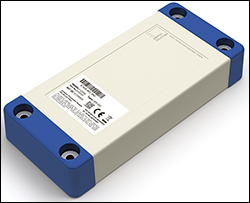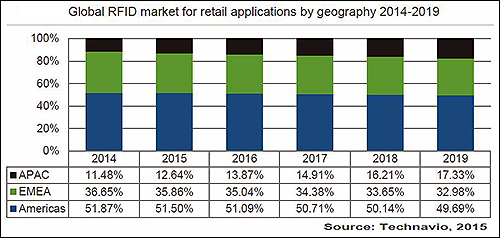The following are news announcements made during the past week by the following organizations:
Identec Solutions;
Beaconinside;
Thinfilm, FlexTech Alliance;
Technavio Research; and
Schreiner LogiData.
New Identec Solutions Tag Combines RFID, GPS, Satellite Communications
Identec Solutions has announced a new asset-tracking tag designed for the oil and gas industry. The I-Q350LX GPS SAT tag combines RFID, GPS and satellite communications technologies, is ATEX-certified and is built to withstand harsh environments, according to the company. The tag can transmit its GPS position either via RFID or via the globally available Globalstar satellite network, Identec Solutions reports.
The i-Q350LX GPS-SAT is a battery-powered tag that transmits an ultrahigh-frequency (UHF) signal that can be received by Identec readers located up to 250 meters (800 feet) away. The tags can also receive location-related data via 125 kHz signals from i-Mark position markers, and then forward those i-Marks’ ID numbers to an Identec reader (such as Identec’s i-Port M350, i-Card CF 350 or i-Port 4-350). It features Globalstar’s simplex satellite transmitter, according to Identec Solutions—a benefit for customers who need to monitor containers and high-value assets dispersed in remote and harsh environments with maximized efficiency of both power and cost. A user can turn off the satellite transmitter by means of the tag’s RFID module, the company adds, thereby significantly reducing the monthly communication costs.
The I-Q350LX GPS SAT tag is rated IP69K (indicating it can withstand shock, vibration and water) and has an ATEX/IECEx Zone 0 certification for use in hazardous explosive environments. Identec Solutions has added the iQ350LX GPS/SAT tag to it existing solution platform, WatcherLogistics, developed specifically for oil and gas companies carrying out operations all around the globe, both land-based and offshore.
Beaconinside Launches Second-Gen Beacon Hardware and Software
Proximity provider Beaconinside, headquartered in Berlin, Germany, has announced the second generations of its Beaconinside Beacon hardware and Beaconinside Manage software platform. These new versions of the company’s technology now offer full support for Apple iBeacon and Google Eddystone.
In addition, the company says it has enhanced the flexibility of its software by opening up its Bluetooth service specification for other proximity service providers in order to offer multi-vendor solutions, as well as to integrate into existing back-end and mobile systems. Beaconinside beacons come with batteries made by German manufacturer Varta, and are made with Texas Instruments‘ CC2640 Bluetooth Low Energy (BLE) chip, which the company says increases the life span of the battery in the beacons from two years to more than five years. In addition, the firm reports that it has upgraded the security features of the hardware and software. The new beacons come with advanced security features in order to avoid the misuse of a beacon deployment, and both the Beaconinside Beacon and Manage products now protect users from unauthorized “beacon harvesting” (the reading out of networks) and spoofing (the cloning of beacons).
In addition to the new versions of Beaconinside hardware and software, the company has announced that its technology is being used by Reload Labs for the global launch of a new lifestyle perfume product called Reload at 1,300 shops in 27 countries on three continents. The beacons are integrated invisibly into the point-of-sale (POS) displays (one per store), and work together with a Reload mobile app. The Reload fan community receives exclusive offers, product information and previews of new products via the app, according to Beaconinside. Additionally, perfumery and drugstore chains can use the beacon infrastructure for their own apps, since Beaconinside Manage works with a variety of beacons. The Reload implementation was completed two months ago, and Beaconinside plans to install additional beacons as the product arrives in more shops.
Beaconinside’s newest beacon generation is now available via its online shop.
Thinfilm Receives $350K Through FlexTech Alliance to Extend Sensor Platform
Thinfilm Electronics Inc., the U.S. subsidiary of printed electronics company Thin Film Electronics (Thinfilm), has announced that it will receive $350,000 in funding through the FlexTech Alliance to create smart labels featuring next-generation sensors and Near Field Communication (NFC) capabilities. Through the project, Thinfilm says, it plans to extend the scope and versatility of its proprietary technology and smart label platform, while maintaining alignment with established processes for high-volume label manufacturing.
The FlexTech Alliance is an industry association focused on growth, profitability and success throughout the manufacturing and distribution chain of flexible, printed electronics. Its research and development (R&D) program supports the development of a manufacturing supply chain.
According to Heidi Hoffman, FlexTech’s director, the association has acted as a public and private partnership with the U.S. Department of Defense (DoD) for more than 20 years. Various groups within the DoD have used FlexTech (Including DARPA, Army Research Laboratory and Air Force Research Laboratory) as a vehicle for making technology development investment decisions that might require a cadre of expertise not resident within their unit, she explains. By using FlexTech’s Technical Council and Governing Council, comprising industry leaders and experts, as well as the association’s proposal and funding process, Hoffman explains, the DoD knows that it is investing its research funds in leading-edge proposals for the tools and products that its needs to effectively do its mission. FlexTech’s process also helps to ensure that there is a path to commercialization for the products developed.
“With regard to this project, in particular, DoD has keen interest in asset tracking and advanced sensor development for many of their support missions,” Hoffman states. “So, it is a best-of-both-worlds thing—Thinfilm develops technology that will support DoD’s mission and, at the same time, it de-risks some of its development for the super-high-volume component upon which it may sell to commercial customers. We focus on projects which would not otherwise be on the development path for commercial organizations.”
The FlexTech Alliance requires at least 50 percent cost share by the company carrying out the development, Hoffman says, though it usually exceeds 50 percent.
According to Thinfilm, the thin, flexible smart labels produced by the firm as a result of this project will incorporate one or more sensors that dynamically detect, measure and report on a range of environmental phenomena.
Global RFID Market for Retail to Near $4 billion in 2019, Technavio Finds
The global RFID market for retail applications is expected to be valued at $3.91 billion in 2019, an increase of more than $3 billion from 2014, according to a new study released by Technavio Research. Technavio expects the global RFID market for such applications to grow at a compound annual growth rate of 40 percent during the forecast period.
The report, titled “Global RFID Market For Retail Applications 2015-2019,” divides this market into three major geographical segments. In 2014, the Americas accounted for 52 percent, while the European, Middle East and African (EMEA) market made up about 37 percent and the Asia Pacific (APAC) region had about 11 percent. APAC is expected to grow at the fastest rate during the forecast period, with developing countries like China and India driving the growth, according to Technavio Research. Driving the market in the Americas is the long-term growth prospects in Latin America, the research firm notes. The Americas region is expected to account for approximately 50 percent of the total market in 2019, followed by EMEA with about 33 percent and APAC with about 15 percent.
The study includes a detailed market assessment and opportunities analysis of global RFID market for retail applications; in-depth analysis of key segments and sub-segments by product, by application and by geography; an overview of the technological traction of the RFID industry, its supply chain and value chain, and the cost structure of RFID systems; key regulations, policies and regulatory agencies for RFID systems; and a case study on the tangible benefits—including ease of informed decision making and monetary benefits—of using RFID systems.
Technavio reports that the global retail sector realized total sales of more than $22 trillion last year, and is expected to surpass $28 trillion in sales by 2018. These dynamics are influencing retailers’ demand for RFID technology, the report indicates. Another factor driving the retail sector’s adoption of RFID is growth in sales in the e-commerce market during the forecast period, and leading e-commerce companies are competing on the basis of services such as prices and delivery time. RFID enables retailers to reduce operation costs, according to Technavio Research, by decreasing delivery cycle times and the number of errors—delivering the wrong product, for instance.
Schreiner LogiData Unveils New NFC Label for Android Smartphones
Schreiner LogiData, Schreiner Group‘s business division and competence center for RFID, has announced that it has developed an NFC-Nameplate label designed to enable Android smartphone users to read or encode tags and automatically access defined websites. Companies can use the NFC-Nameplate label to ease product maintenance, run targeted e-marketing campaigns and compile inventories.
Near Field Communication (NFC) was originally designed for payment systems, Schreiner LogiData explains, but with the number of NFC-enabled smartphones increasing, other fields of application have emerged. The NFC-Nameplate combines the nameplate or service label with NFC technology and works with all substrates. Users can obtain additional information when reading the tag via their NFC smartphone. The label can work with mobile, NFC-enabled apps developed by consumer goods manufacturers or other companies. Schreiner LogiData does not develop the apps. The firm leverages a variety of NFC chips in the NFC-Nameplate and offers several options of the label with different memory capacities of up to 8 kilobytes.
As an example, Schreiner LogiData notes, maintenance and service personnel can use a customized app to read the tag via their smartphone. They can, for instance, access service parameters and store data locally on the chip, the company explains. This data can be combined to create a service history, thus making all related activities significantly more transparent. Stored Web links guide personnel directly to the product site, where they can find circuit diagrams, spare parts or service instructions. For e-marketing, the NFC-Nameplate can serve as a channel for direct customer contact. When reading the NFC-Nameplate, the company says, an end consumer can be automatically guided to the corresponding homepage, which displays current offers and information about product use, consumables, warranty services and so forth. There are also opportunities in the field of inventory compilation. With NFC, smartphones can be used to detect objects across companies and countries, and to store the collected data in a central database. At the same time, Schreiner LogiData reports, the “last read” date is written on the NFC tag.
A significant benefit of the NFC-Nameplate is the universal integration into the device, according to the company. The label is invisible from the outside, works on all substrates and can be read through plastic, wood and glass. This allows designers to focus on product design and decide on the tag’s location later, Schreiner LogiData explains. Individual optical NFC scanning points inform end consumers where they can read the stored information. According to the company, the NFC-Nameplate can, for instance, be hidden on the inside of the housing.



